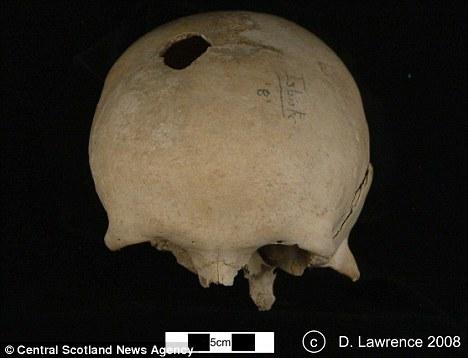The skull that proves those New Stone Age farmers weren't so peaceful after all...
Source - http://www.dailymail.co.uk/sciencetech/article-1364489/85-New-Stone-Age-skulls-head-injuries-Orkneys-Tomb-Eagles.html
Scientists find evidence of women and children killed by violent attacks
A large number of New Stone Age men, women and children may have suffered serious violent attacks and died from their injuries, scientists believe.
Human skulls buried in Orkney's famous Tomb of the Eagles displayed signs of serious wounds inflicted by weapons, according to ground-breaking research.

Archaelogists who studied all 85 skulls from in and around the 5,000-year-old tomb said 16 contain ‘clear evidence’ of trauma.
The findings give the lie to the long-held belief that the people who lived in Scotland in the New Stone Age were peaceful farmers and that the human race did not turn murderous and warlike until later in pre-history.
'Clear evidence': A large number of New Stone Age men, women and children suffered serious violent attacks and died from their injuries, scientists believe
The skulls - both male and female, children and adults - showed injuries caused by one or more severe blows to the head inflicted by a weapon.
Some of these severe head wounds healed - leaving some people with painful head injuries.
But Orkney-based archaeologist David Lawrence, who led the investigation and revealed his preliminary findings, said it was likely that many died of their injuries.
Mr Lawrence undertook the research in a collaborative project between the University of Bradford and Orkney Museum, funded by the Arts and Humanities Research Council.
The results are to be peer-reviewed and formally published 'shortly'.
Mr Lawrence said: ‘By checking if the wounds were healed or not, we can see if someone suffered from severe head trauma just around the time if their death.
‘To say with absolute certainty if they actually died from it, is very hard, but some attacks were so severe that the whole skull has split in two horizontally.
‘Other wounds are very subtle and are most easily observed inside the skull, where splinters have been bent inwards.
‘Some were caused by a blunt force, like a stone or a mace. Other cases were caused by pointed objects, like a bone headed arrow and there were also traumas caused by edged objects, like an axe.
‘Some wounds did heal. There is a skull of a woman that has three healed wounds which were caused by blows from a blunt object.
‘She also had a dislocated jaw which was badly healed. She must have suffered terribly, as it would have been very difficult for her to chew properly. It is likely she also had problems speaking.’

An artist's impression of what a Stone Age young man would look like
The study's main finding - that Scotland's early settlers were not the friendly farmers that historians for a long time thought them to be - is in line with recent results from studies and finds in Europe.
Mr Lawrence said: ‘For a long time it was thought Neolithic people were friendly farmers, but in recent years it has been proven that this was not necessarily the case.
‘My study shows this again, but this time on an apparently remote island.’
Mr Lawrence is convinced that the people in the Tomb of the Eagles were not ritually killed.
He said: ‘There was a great variety in the places where people were hit and the instruments used: there is no simple pattern. This variety makes it very unlikely that they were killed in some kind of ritual.
‘Some wounds are too directed to be an accident either. Some went straight through the skull. Many were very likely caused by a mace, or even just stones but certainly caused with intent.
‘I think it is very likely that some of the head injuries were suffered during fights face to face. I can't say if they were fighting each other or different tribes.
‘It is hard to tell who these particular people were, and why they were buried in this tomb. There is still a lot of carbon dating to do, but most of the bones seem to date from the fourth millennium BC, though some are from the third.
‘This tomb was in use for a very long time - maybe even more than a thousand years - and in that time, 85 burials is not that much. It is therefore unlikely it was used as a general burial tomb, though it being just for some hereditary elite is also very unlikely, as the numbers are much too low for that.
‘One plausible theory is that it was a grave for people who had suffered 'unaccepted' deaths - people who were murdered, died by accident or who were from other tribes.’

Isbister Chambered Cairn - better known as the Tomb of the Eagles - sits on the south-eastern tip of South Ronaldsay

TOMB OF THE EAGLES
Isbister Chambered Cairn - better known as the Tomb of the Eagles - sits on the south-eastern tip of South Ronaldsay.
Alongside 16,000 human bones, 70 talons from the white-tailed sea eagle were found within it. It is believed the magnificent birds, once common in Orkney, were perhaps a totem of the people who built the tomb.
The tomb is 3.5 metres high and consists of a rectangular main chamber, divided into stalls and side cells.
The tomb was accidentally discovered in 1958 by local farmer Ronnie Simison, when he was looking for stone to make corner posts for fencing.
After noticing flagstones jutting from a mound in a field, Mr Simison began digging and was astounded when, ten minutes later, he reached the bottom of what looked like a wall.
He eventually found a dark hole and using a cigarette lighter, he revealed a chamber containing approximately 30 human skulls - his first encounter with his 5000 year old ancestors.